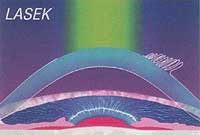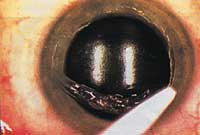LASEK is an option for non-LASIK candidates
We all have patients who would be good refractive surgery candidates — that is, until we find they’re 8-D myopes with 453 µm corneal thickness, map-dot-fingerprint corneal dystrophy and 47-D K readings.
Do we need to tell these patients that refractive surgery is not an option for them? Luckily we don’t have to, because laser-assisted subepithelial keratectomy (LASEK) is a viable alternative for them.
The LASEK procedure involves trephination, leaving a hinge at 12:00. The trephine is centered on the cornea and rotated 10°. Trephination is followed by application of a diluted 20% alcohol solution, which flows through the trephinated area to Bowman’s. An epithelial spatula or instrument of choice is used to push the epithelium away and toward the 12:00 position. The laser treatment is applied, and the epithelium is spread back into place. In many cases, the epithelium comes back in a continuous sheet with minimal loss. A bandage silicone hydrogel contact lens is placed.
LASEK is a desirable option for people with thin corneas, small orbits, dry eye or high-risk occupations or activities (see accompanying chart).
| ||||
Postop medication regimen
To promote haze-free healing, LASEK patients are instructed to take 1,000 mg of vitamin C from 2 weeks preop to 2 weeks postop. The topical drop regimen may include Zymar (gatifloxacin, Allergan) one drop four times daily, Pred Forte (prednisolone acetate, Allergan) or Lotemax (loteprednol etabonate, Bausch & Lomb) four times daily, Acular (ketorolac tromethamine, Allergan) four times daily for 2 days, Refresh Tears (polyvinyl alcohol, Allergan) four times daily and Tylenol (acetaminophen, McNeil) three times daily for 1 day.
The patient is seen back the following day. Re-epithelialization is typically underway, although the extent of healing is patient-dependent. Most patients are quite comfortable, given the use of the bandage contact lens and the Acular.
By postop day 3, most LASEK patients (87%) are completely re-epithelialized, and any haze is clearing. This is in sharp contrast to 20% by day 3 for photorefractive keratectomy (PRK) patients. If the epithelial healing is complete, the bandage contact lens is removed. If healing is incomplete, the bandage contact lens is changed.
The patient is seen again at 1-week postop. Zymar is continued until re-epithelialization is complete. Topical steroids are tapered as follows: four times daily for 2 weeks; three times daily for 2 weeks; twice daily for 2 weeks and once a day for 6 weeks. Antibiotic and steroid regimens may be adjusted depending on healing and haze.
Although the LASEK patient’s best visual acuity is slower to come around (from 1 week to 2 months), many are delighted with the final visual outcome. For most, discomfort is minimal, and sometimes post-LASEK patients are even more comfortable day 1 than LASIK patients.
 |
 |
| Artist’s depiction: The LASEK procedure involves trephination, leaving a hinge at 12:00. (Left) LASEK eye following treatment with diluted alcohol: A diluted 20% alcohol solution is applied and flows through the trephinated area to Bowman’s. The epithelium has been moved aside to allow laser treatment. (Right) |
|
LASEK advantages
Several studies paint LASEK in a favorable light. Autrata and Rehurek reported that LASEK provides quicker visual recovery as well as better refractive effect, predictability and stability than hyperopic PRK (Autrata R, Rehurek J. LASEK & PRK for the correction of hyperopia: Results of a 2-year follow-up. J Cat Refract Surg. 2003;29:2105-2114).
Claringbold concluded that “LASEK for myopia provided excellent refractive and visual results with no loss of [best spectacle-corrected visual acuity] and no serious complications” (Claringbold T. LASEK for the correction of myopia. J Cat Refract Surg. 2002;28:18-22).
Don’t overlook LASEK as an option for your patients. This very elegant procedure has an important place in the refractive surgery armamentarium.
For Your Information:
- Heather Cowden, OD, FAAO, practices at the Bergstrom Eye and Laser Clinic, Fargo, N.D. She can be reached at 827 28th Street SW, Suite B, Fargo, ND 58103; (701) 235-5200; fax: (701) 237-0927. Dr. Cowden has no direct financial interest in the products mentioned in this article, nor is she a paid consultant for any companies mentioned.
